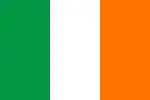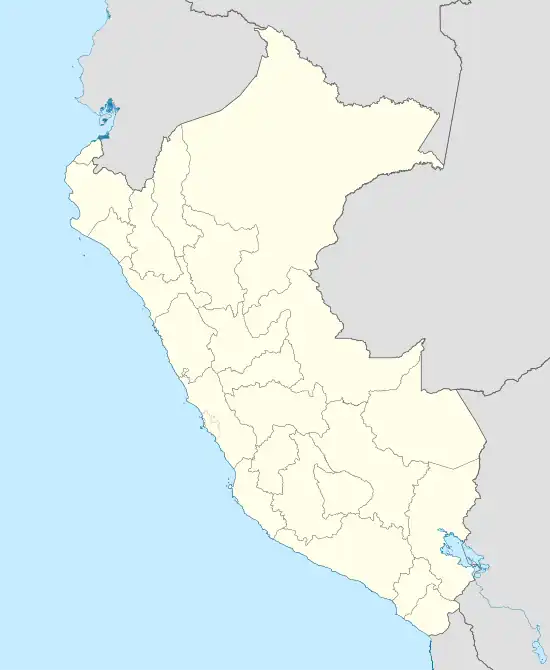Chulucanas
Chulucana | |
|---|---|
Town | |
 | |
 Flag | |
 Chulucanas Location in Peru | |
| Coordinates: 05°05′46″S 80°09′53″W / 5.09611°S 80.16472°W | |
| Country | |
| Region | Piura Region |
| Province | Morropón |
| District | Chulucanas |
| Government | |
| • Mayor | Nelson Mio Reyes |
| Elevation | 92 m (302 ft) |
| Population (2017) | |
| • Total | 82,521 |
| • Estimate (2015)[1] | 57,380 |
Chulucanas is a town in Morropón Province, Piura Region, Peru.[2] It lies in the Piura Valley just north of the confluence of the Charanal River[3] with the Piura River.[4] Chulucanas is the administrative seat for both Chulucanas District and Morropón Province.
The town is famous for its pottery. Originally dating from pre-Inca times it is today exported all over the world.[5] It is one of seven products that the Peruvian government supports through its Center for Technological Innovation (CITE).[6] Designs are varied, but are predominated by black and white. There are several bigger companies but a lot of small manufactures are in Chulucanas itself and in the nearby village of Quatro Esquinas.
A major festival for the town is the Fiesta de Cristo Resucitado at Easter.[7]
Operating in Chulucanas is Victor's Vision, a nonprofit organization which provides supplemental academic and personal support, guidance, and resources to bright, impoverished youth.[8]
In 2013, Chulucanas recorded a temperature of 39.8 °C (103.6 °F), which is the joint highest temperature to have ever been recorded in Peru along with the Lancones District.[9]
Ceramics production in Chulucanas
The region of Chulucanas – in the province of Morropón – produces a type of ceramic officially labeled with the appellation of origin Chulucanas.
The main natural components of Chulucanas pottery are clay, sand, mango leaves and the climate. For the elaboration of Chulucanas ceramics, the clay is extracted from certain quarries containing mainly yellow clay (arcilla amarilla) and black clay (arcilla negra). These particular types of clay contain divided particles that characterize not only their plasticity, but also their organic content of iron oxide and organic waste. The type of clay is also responsible for giving brightness to the ceramic when it is burnished.
The craftsmen of Chulucanas use distinctive ancestral techniques from ancient cultures such as the Vicús and the Tallán. Before completion, each ceramic piece will undergo a dozen steps. The artisans mold the raw clay with their hands and feet, and then use wooden pallets and stones in order to better shape it. The first colors, derived from natural sources such as leaves and soil pigment, are added. Then the pieces are placed in an oven and submerged for hours in the smoke of burning mango leaves, which give Chulucanas pottery its characteristic black color. To complete the piece, the ceramic is polished by hand with a black stone, to give it a brilliant shine.
In 2006, the Asociación de Ceramistas Vicús, the Asociación Civil de Ceramistas Tierra Encantada and the CITE Cerámica de Chulucanas filed a request for the appellation of origin Chulucana, which was registered in 2008.[10]
Notes and references
- ↑ Perú: Población estimada al 30 de junio y tasa de crecimiento de las ciudades capitales, por departamento, 2011 y 2015. Perú: Estimaciones y proyecciones de población total por sexo de las principales ciudades, 2012-2015 (Report). Instituto Nacional de Estadística e Informática. March 2012. Retrieved 4 June 2015.
- ↑ Chulucanas (Approved - N) at GEOnet Names Server, United States National Geospatial-Intelligence Agency
- ↑ Río Charanal (Approved - N) at GEOnet Names Server, United States National Geospatial-Intelligence Agency
- ↑ Piura, Peru, SB 17-07, (Map) (second ed.). 1:250,000. Joint Operations Graphic, Series 1501 Air. United States Armay Topographic Command. 1994.
- ↑ Carmen, Jim (26 November 2007). "Alejandro Suyon and the Making of Chulucanas Pottery". eBay Guides. Archived from the original on 26 May 2014.
- ↑ Ministerio de Comercio Exterior y Turismo (MINCETUR) (June 2007). "Plan de desarrollo del mercado de Estados Unidos de América" (PDF). pp. 348–349. Archived from the original (PDF) on 5 April 2015. Retrieved 5 April 2015.
- ↑ "Chulucanas vive la fiesta de Cristo Resucitado". Chulucanas Noticias. 5 April 2015. Archived from the original on 8 April 2015. Retrieved 8 April 2015.
- ↑ "Victor's Vision: Our Story". Victor's Vision. Archived from the original on 19 April 2017. Retrieved 5 April 2015.
- ↑ PERU21, NOTICIAS (26 January 2019). "Récords de calor en el norte | OPINION". Peru21 (in Spanish). Retrieved 25 January 2022.
{{cite web}}: CS1 maint: numeric names: authors list (link) - ↑ "Geographical Indications: An Introduction, 2nd edition". www.wipo.int. p. 10. Retrieved 5 December 2023.